The fastest orbiting asteroid, discovered thanks to the powerful 570 Mpixel Dark Energy Camera

The fastest orbiting asteroid
Using the powerful 570 megapixel Dark Energy Camera (DECam) found in Chile, astronomers recently discovered an asteroid with the shortest orbital period of any known asteroid in the Solar System. The asteroid's orbit of about 1 kilometer in diameter brings it close to 20 million kilometers from the Sun every 113 days. The asteroid 2021 PH27, revealed in images acquired during twilight, also has the smallest average distance (semi-major axis) of any known asteroid in our Solar System.Only Mercury has a shorter period and a semi-axis larger smaller. The asteroid is so close to the Sun's massive gravitational field that it experiences the greatest general relativistic effects of any known object in the Solar System.
The asteroid named 2021 PH27 was discovered by Scott S. Sheppard of Carnegie Institution of Science by observing data collected by the Dark Energy Camera (DECam), mounted on the Víctor M. Blanco 4-meter Telescope at the Cerro Tololo Inter-American Observatory (CTIO) in Chile. Twilight, just after sunset or before sunrise , is the best time to hunt for asteroids that are inside the Earth's orbit, in the direction of the two innermost planets, Mercury and Venus. As any astronomer knows, Mercury and Venus never seem to move very far from the Sun in the sky and are always better visible near sunrise or sunset. The same is also true for asteroids that orbit close to the sun.
Following the discovery of PH27 in 2021, David Tholen of the University of Hawaii measured the position of the asteroid and predicted where it could be observed the following evening. Then, on August 14, 2021, it was observed once again by DECam, and also by Magellan telescopes at the Las Campanas Observatory in Chile. Then, on the evening of 15, Marco Micheli of the European Space Agency used the network of 1 to 2 meter telescopes of the Las Cumbres Observatory to observe it from CTIO in Chile and South Africa, as well as further observations from DECam and Magellan.
2021 PH27 may have started life in the main asteroid belt between Mars and Jupiter and being displaced by gravitational disturbances from the inner planets that brought it closer to the Sun. Its high orbital inclination of 32 degrees suggests, however, that it could also be an extinct comet from the outer Solar System, which was captured in a nearer short-term orbit. Future observations of the asteroid will shed more light on its origins.
Its orbit is likely unstable over long periods of time, and will likely eventually collide with Mercury, Venus, or the Sun in a few million years, or it will be ejected from the inner Solar System by the gravitational influence of the inner planets.
Astronomers have a hard time finding these inner asteroids because they are very often hidden from the sun's glow. When asteroids get so close to our star closer, they experience a variety of stresses, such as the thermal stresses of the sun's heat and the physical stresses of the gravitational forces of the tides. These stresses could cause some of the more fragile asteroids to rupture.
“Understanding the asteroid population within Earth's orbit is important in completing the census of near-Earth asteroids, including some of the most likely impactors that can approach the Earth during the day and which cannot be easily detected in most surveys carried out at night, away from the Sun, "says Sheppard, who then added that 2021 ph27 is so close to the Sun that" his surface temperature reaches nearly 500 ° C, enough to melt lead.
Fastest Orbiting Asteroid Discovered Using the Powerful 570-Megapixel Dark Energy Camera
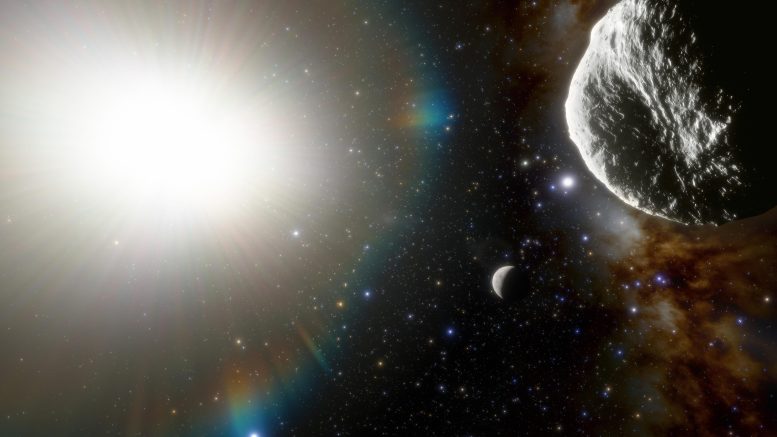
The fastest asteroid in the Solar System has been discovered at NOIRLab’s CTIO using the powerful 570-megapixel Dark Energy Camera (DECam) in Chile — the Sun’s new nearest neighbor. Astronomers just ten days ago discovered an asteroid with the fastest orbital period of any known asteroid in the Solar System. The orbit of the approximately 1-kilometer-diameter asteroid takes it as close as 20 million kilometers (12 million miles or 0.13 au), from the Sun every 113 days. This artist’s rendering shows the asteroid (above) and the planet Mercury (below). Credit: CTIO/NOIRLab/NSF/AURA/J. da Silva (Spaceengine)
About a kilometer across, space rock 2021 PH27 is the Sun’s nearest neighbor.
Using the powerful 570-megapixel Dark Energy Camera (DECam) in Chile, astronomers recently discovered an asteroid with the shortest orbital period of any known asteroid in the Solar System. The orbit of the approximately 1-kilometer-diameter asteroid takes it as close as 20 million kilometers (12 million miles or 0.13 au), from the Sun every 113 days. Asteroid 2021 PH27, revealed in images acquired during twilight, also has the smallest mean distance (semi-major axis) of any known asteroid in our Solar System — only Mercury has a shorter period and smaller semi-major axis. The asteroid is so close to the Sun’s massive gravitational field, it experiences the largest general relativistic effects of any known Solar System object.

Discovery observations of 2021 PH27 from August 13, 2021. The asteroid was imaged inside Mercury’s orbit and has been colored red and blue to show the two different times where it was imaged on the discovery night of August 13, 2021 — just three minutes apart. Credit: CTIO/NOIRLab/NSF/DOE/DECam/AURA/S.S. Sheppard (Carnegie Institution of Science)
The asteroid designated 2021 PH27 was discovered by Scott S. Sheppard of the Carnegie Institution of Science in data collected by the Dark Energy Camera (DECam) mounted on the Víctor M. Blanco 4-meter Telescope at Cerro Tololo Inter-American Observatory (CTIO) in Chile. The discovery images of the asteroid were taken by Ian Dell’antonio and Shenming Fu of Brown University in the twilight skies on the evening of August 13, 2021. Sheppard had teamed up with Dell’antonio and Fu while conducting observations with DECam for the Local Volume Complete Cluster Survey, which is studying most of the massive galaxy clusters in the local Universe.[1] They took time out from observing some of the largest objects millions of light-years away to search for far smaller objects — asteroids — closer to home.
One of the highest-performance, wide-field CCD imagers in the world, DECam was designed for the Dark Energy Survey (DES) funded by the DOE, was built and tested at DOE’s Fermilab, and was operated by the DOE and NSF between 2013 and 2019. At present DECam is used for programs covering a huge range of science. The DECam science archive is curated by the Community Science and Data Center (CSDC). CTIO and CSDC are programs of NSF’s NOIRLab.
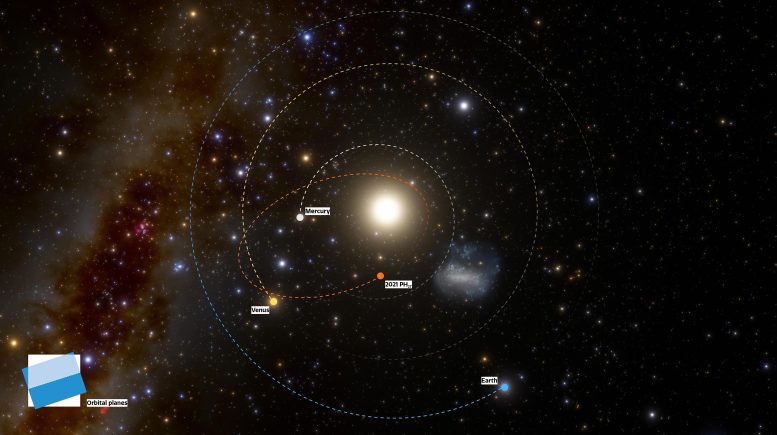
The fastest orbital period asteroid in the Solar System has been discovered at NOIRLab’s CTIO using the powerful 570-megapixel Dark Energy Camera (DECam) in Chile — the Sun’s new nearest neighbor. The illustration shows the locations of the planets and asteroid on the discovery night of August 13, 2021, as they would be seen from a vantage point above the Solar System (north). Credit: CTIO/NOIRLab/NSF/AURA/J. da Silva (Spaceengine)
Twilight, just after sunset or before sunrise, is the best time to hunt for asteroids that are interior to Earth’s orbit, in the direction of the two innermost planets, Mercury and Venus. As any stargazer will tell you, Mercury and Venus never appear to get very far from the Sun in the sky and are always best visible near sunrise or sunset. The same holds for asteroids that also orbit close to the Sun.
Following 2021 PH27’s discovery, David Tholen of the University of Hawai‘i measured the asteroid’s position and predicted where it could be observed the following evening. Subsequently, on August 14, 2021, it was observed once more by DECam, and also by the Magellan Telescopes at the Las Campanas Observatory in Chile. Then, on the evening of the 15th, Marco Micheli of the European Space Agency used the Las Cumbres Observatory network of 1- to 2-meter telescopes to observe it from CTIO in Chile and from South Africa, in addition to further observations from DECam and Magellan, as astronomers postponed their originally scheduled observations to get a sight of the newly found asteroid.

View of orbits face-on. The illustration shows the locations of the planets and the asteroid on the discovery night of August 13, 2021, as they would be seen from a vantage point in the plane of the Solar System. The relatively high inclination of 32 degrees means the asteroid could be an extinct comet from the outer Solar System that got captured into a short period orbit when passing near one of the terrestrial planets. Future observations will shed more light on its origins. Credit: CTIO/NOIRLab/NSF/AURA/J. da Silva (Spaceengine)
“Though telescope time for astronomers is very precious, the international nature and love of the unknown make astronomers very willing to override their own science and observations to follow up new, interesting discoveries like this,” says Sheppard.
Planets and asteroids orbit the Sun in elliptical (or oval-shaped) orbits, with the widest axis of the ellipse having a radius described as the semi-major axis. 2021 PH27 has a semi-major axis of 70 million kilometers (43 million miles or 0.46 au), giving it a 113-day orbital period on an elongated orbit that crosses the orbits of both Mercury and Venus.[2]
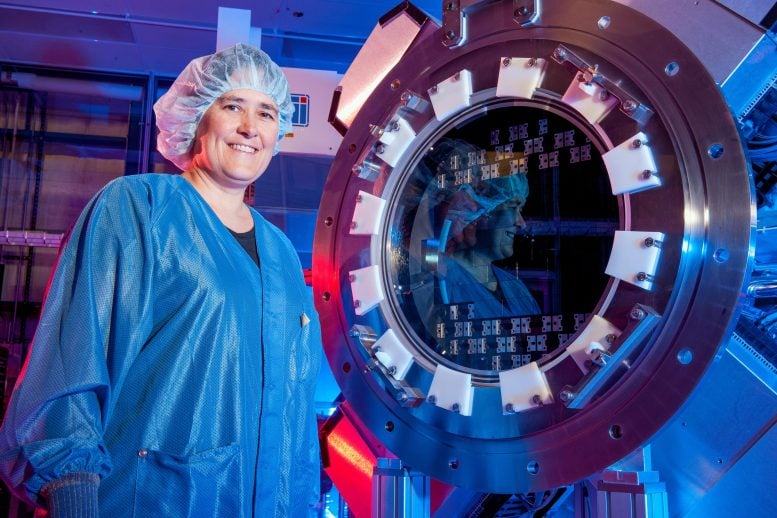
Dark Energy Survey (DES), Dark Energy Camera imager and CCDs at SiDet. Credit: DOE/FNAL/DECam/R. Hahn/CTIO/NOIRLab/NSF/AURA
It may have begun life in the main Asteroid Belt between Mars and Jupiter and got dislodged by gravitational disturbances from the inner planets that drew it closer to the Sun. Its high orbital inclination of 32 degrees suggests, however, that it might instead be an extinct comet from the outer Solar System that got captured into a closer short-period orbit when passing near one of the terrestrial planets. Future observations of the asteroid will shed more light on its origins.
Its orbit is probably also unstable over long periods of time, and it will likely eventually either collide with Mercury, Venus or the Sun in a few million years, or be ejected from the inner Solar System by the inner planets’ gravitational influence.
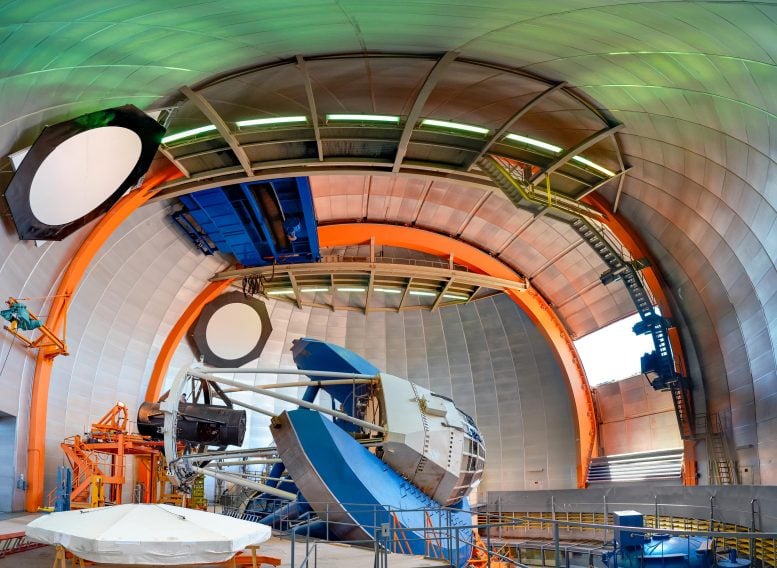
A view of the Víctor M. Blanco 4-meter Telescope at the Cerro Tololo Inter-American Observatory in Chile. Credit: CTIO/NOIRLab/NSF/AURA/D. Munizaga
Astronomers have a hard time finding these interior asteroids because they are very often hidden by the glare of the Sun. When asteroids get so close to our nearest star, they experience a variety of stresses, such as thermal stresses from the Sun’s heat, and physical stresses from gravitational tidal forces. These stresses could cause some of the more fragile asteroids to break up.
“The fraction of asteroids interior to Earth and Venus compared to exterior will give us insights into the strength and make-up of these objects,” says Sheppard. If the population of asteroids on similar orbits to 2021 PH27 appears depleted, it could tell astronomers what fraction of near-Earth asteroids are piles of rubble that are loosely held together, as opposed to solid chunks of rock, which could have consequences for asteroids that might be on a collision course with Earth and how we might deflect them.
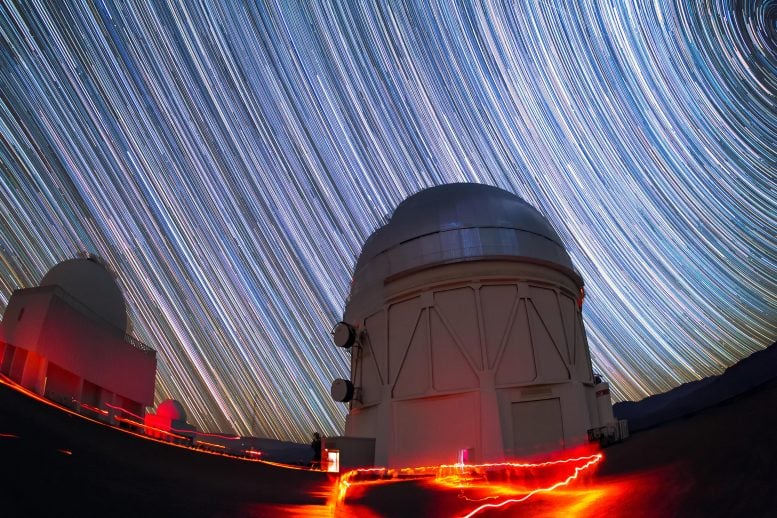
Víctor M. Blanco 4-meter Telescope at the Cerro Tololo Inter-American Observatory (CTIO), a Program of NSF’s NOIRLab. Credit: CTIO/NOIRLab/NSF/AURA/R. Sparks
“Understanding the population of asteroids interior to Earth’s orbit is important to complete the census of asteroids near Earth, including some of the most likely Earth impactors that may approach Earth during daylight and that cannot easily be discovered in most surveys that are observing at night, away from the Sun,” says Sheppard. He adds that since 2021 PH27 approaches so close to the Sun, “…its surface temperature gets to almost 500 degrees C (around 900 degrees F) at closest approach, hot enough to melt lead.”
Because 2021 PH27 is so close to the Sun’s massive gravitational field, it experiences the largest general relativistic effects of any known Solar System object. This reveals itself as a slight angular deviation in the asteroid’s elliptical orbit over time, a movement called precession, which amounts to about one arcminute per century.[3]
The asteroid is now entering solar conjunction when from our point of view it is seen to move behind the Sun. It is expected to return to visibility from Earth early in 2022, when new observations will be able to determine its orbit in more detail, allowing the asteroid to get an official name.
NotesFor more on this discovery, read Solar System’s Fastest-Orbiting Asteroid Discovered – Orbits the Sun in Just 113 Days.